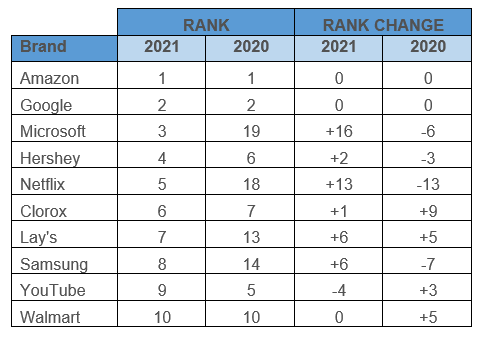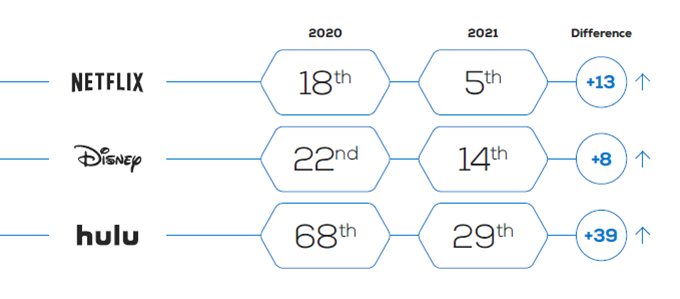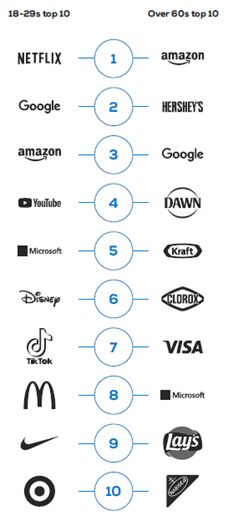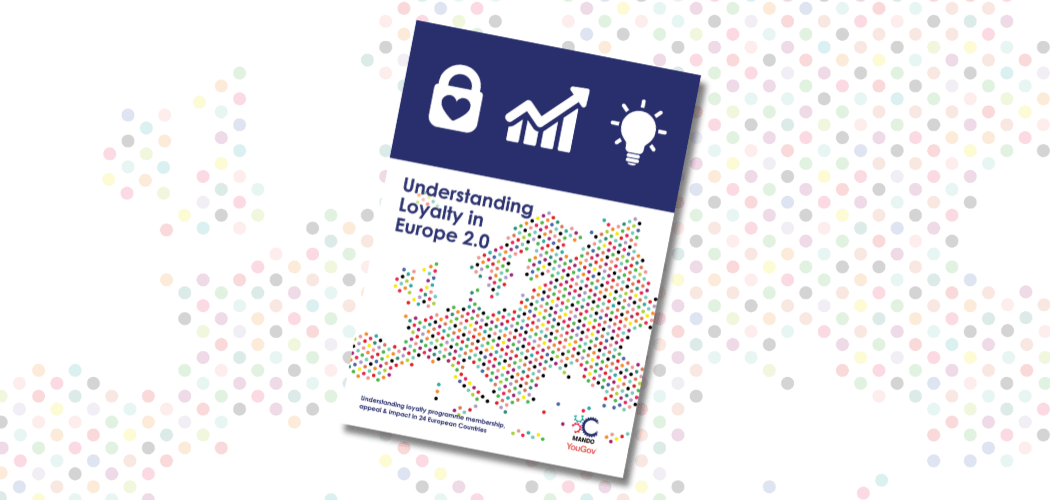At the end of another year, with all eyes on Christmas but ears attentive to news of Omicron, we take a look back at the brand winners of 2021. Who are the brands that have been front of mind for consumers, building strong connections in these troubled times and what can we learn from them as we head into 2022?
Opinium’s Most Connected Brands shows, unsurprisingly, that the winning brands are those that have succeeded in becoming indispensable to consumers’ daily lives.
Amazon takes the number one spot, being the brand that consumers connect with most, followed by Google at number 2. No surprise there you might think. What is interesting is Microsoft rising 16 spots since 2020 to take third place. The sustained transition to remote work means that as our interaction with Microsoft has grown so has our connection with the brand.
What we have seen this year is that the continuing Covid pandemic is impacting our brand connections as we change working and consuming behaviors, often becoming more focused on what brands actually do for us through their products, rather than what they stand for.
We also see that there is a newfound connection towards everyday brands, with affordable retailers like Target, Kohl’s and Dollar Tree, as well as pharmacies like Walgreens and CVS, that have been on the front lines of meeting our everyday necessities during this time.
With Netflix jumping into 5th place, and Hulu and Disney also climbing the tables, it’s clear that as Americans sought to amuse themselves during various stages of Covid restrictions, entertainment platforms took the opportunity to shine.
Top 10 Most Connected Brands in the US
THE RETURN OF THE PRODUCT
Every one of us has been impacted by the turmoil of the last couple of years. Many of us have reassessed our priorities and needs. Perhaps that’s also left us all a bit more grateful for the everyday products, services, and most importantly, the frontline workers that have supported us.
It’s a wonderfully eclectic mix of climbers this year — including grocery stores that kept the shelves stocked, tech brands that allowed us to continue working, and home improvement stores that gave us something to do while we couldn’t leave the house.
Are these glamourous brands? Maybe, but it seems that the pandemic may have made some of us a little bit more pragmatic in terms of which brands we feel connected to — and certainly ones that we see clearly on the products we use each day.
Pharmacies at the forefront of the drive for ‘back to normal’
With the roll out of vaccines across the US, pharmacies have been at the forefront of our lives in the last year in a way we could never have imagined previously. Perhaps more than any other big brands in our daily lives, they’ve played the largest part in the drive to get ‘back to normal’.
And that seems to have impacted the relationship and connection that many of us have with them as brands. Walgreens enters the list for the first time this year at number 23, while CVS has climbed a massive 18 places since the 2020 list.
Streaming cements its place in our lives
The changing ways we engaged with content and entertainment through the pandemic is clear in this year’s list. Netflix jumped 13 places to the near-summit heights of number 5 in the overall list this year.
And it’s not just Netflix, either. Hulu has seen one of the biggest increases we’ve seen from any brand year on year, climbing 39 places to number 29 in the list. Even the mighty Disney has shown an increase this year, as Disney+ cements the brand’s place in people’s everyday lives.
A digital divide
While we should avoid making lazy assumptions based on broad generational cohorts, the truth is that different age cohorts do tend to have different brands that they feel most connected to.
One of the big differences continues to be engagement with tech and digital-oriented brands. In fact for 18-29s, six out of the top ten brands this year might be described as ‘digital-first’ brands, including the entire top five. For those over 60 it’s much more of a mixed bag, with three digital-first brands, just two of which are in the top five.
So, what does this all mean for marketers as we head into an uncertain 2022?
Be dynamic, responding quickly to changes circumstances. Microsoft Teams only launched in 2017 and was in exactly the right place at the right time to capitalize when many firms switched to full-time remote working in 2020. It’s worked hard to make sure it delivers and continues to refine the product.
Move-in. Out of home interactions will remain, but even more so, it is important for marketers to meet people where they are — at home. Seeking new ways to build a presence here could help lift your brand connection, even where it isn’t traditionally associated, perhaps through connections with other more domestic brands.
Who is your audience? Brands and products clearly resonate in different ways between older and young people. It’s vital that brands know who their audience is to both target them appropriately and make sure they’re not alienating others. Hard decisions might have to be made to go after certain groups. Having broad appeal is becoming increasingly harder as society polarises, but where a product does deliver, especially under necessity, we see that it can connect with consumers.








